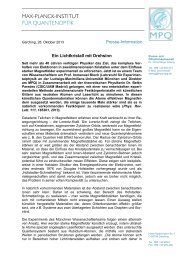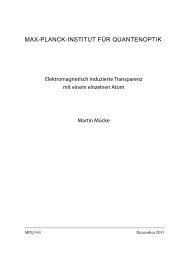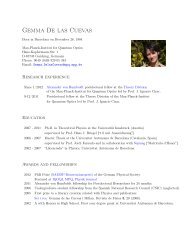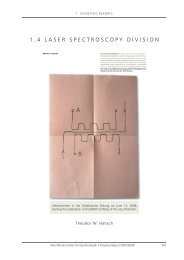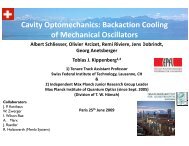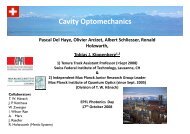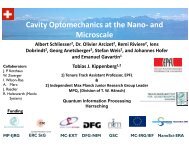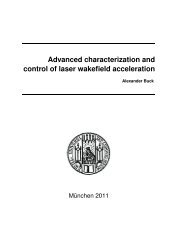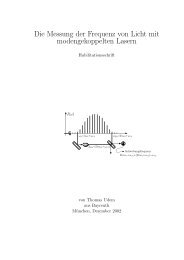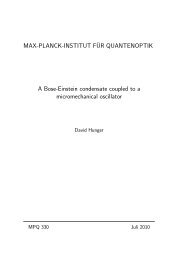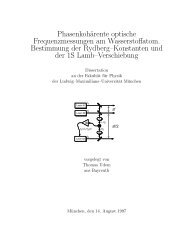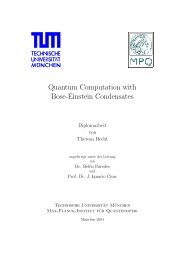Attosecond Control and Measurement: Lightwave Electronics
Attosecond Control and Measurement: Lightwave Electronics
Attosecond Control and Measurement: Lightwave Electronics
You also want an ePaper? Increase the reach of your titles
YUMPU automatically turns print PDFs into web optimized ePapers that Google loves.
data stays consistently below 0.1 rad <strong>and</strong> thus shows<br />
excellent agreement all the way down to ca. 2 U p (below<br />
this value, noise is dominating the curves due to the low<br />
amplitude of the asymmetry). We have demonstrated<br />
that velocity-map imaging is not only a powerful tool<br />
for measuring the full momentum distributions of ATI<br />
in rare gases but also provides a new way to determine<br />
the CEP of few-cycle laser pulses from the angular<br />
distribution of the emitted electrons.<br />
WAVEFORM CONTROl OF ElECTRON lOCAlIZATION<br />
IN MOlECUlES<br />
A previously explored single-color control scheme for<br />
attosecond electron localization in molecules is difficult<br />
to extend to systems with dissociation times much longer<br />
than the duration of the waveform-controlled fewcycle<br />
laser field (in previous experiments, 5 fs pulses at<br />
760 nm were used) as the field strength of the laser will<br />
be to low to coherently couple two electronic states<br />
close to the break-up of the molecule.<br />
As a demonstration for a suitable way to extend the<br />
control scheme, in collaboration with the groups of Anne<br />
L’Huillier (Lund), Marc Vrakking (Amolf), Franck Lepine<br />
(Lyon) <strong>and</strong> Mauro Nisoli (Milan), we have performed<br />
a two-color experiment, where an isolated attosecond<br />
laser pulse ionizes D <strong>and</strong> part of the ionized molecules<br />
2<br />
dissociate. The single attosecond pulse is generated by<br />
means of high-harmonic generation in Krypton using the<br />
polarization gating technique. In the photo-ionization<br />
+ by the attosecond pulse the repulsive 2pσ state is<br />
u<br />
populated when the photon-energy of the pulse is high<br />
enough (above ca. 29 eV). Interaction of this dissociating<br />
wave packet with a time delayed moderately strong IR<br />
field localizes the electron on the upper or lower D + ion.<br />
By varying the delay between the XUV pulse <strong>and</strong> the<br />
few-cycle IR pulse the asymmetry in the ejection of D +<br />
ions can be controlled with attosecond time resolution.<br />
This experiment may be viewed as a first example of<br />
the observation of attosecond time-resolved electron<br />
dynamics in molecular physics. As seen in Figure 2 the<br />
asymmetry shows a strong dependence on the kinetic<br />
energy of the D + fragment.<br />
A model solving the 1D time-dependent Schrödinger<br />
equation (TDSE) was used to confirm the interpretation<br />
<strong>and</strong> to give insight into the origin of the observed<br />
energy dependence. In the model a nuclear wave<br />
+ packet is projected on the repulsive 2pσ state <strong>and</strong><br />
u<br />
+ propagated on the bound 1sσ <strong>and</strong> the repulsive<br />
g<br />
+ 2pσ state of the molecular ion in the presence of a<br />
u<br />
few-cycle IR field. The IR field couples the two states<br />
which generates a coherent superposition where the<br />
electron can be localized on one or the other ion. Just as<br />
in the experiment the timing of the IR field determines<br />
the electron localization. The kinetic energy dependence<br />
1 . 3 AT T O S E C O N D A N D H I G H - F I E L D D I V I S I O N<br />
Figure 2: A) D + ion kinetic energy spectra from the<br />
dissociative ionization of D 2 versus the delay between<br />
the 300 as XUV pulse at 30 eV <strong>and</strong> a phase-stable<br />
6-fs IR pulse; B) Asymmetry of the D + ion emission<br />
along the laser polarization as a function of the D +<br />
kinetic energy <strong>and</strong> the delay between the XUV <strong>and</strong><br />
IR pulses.<br />
of the electron localization, which is observed in the<br />
experiment <strong>and</strong> the calculations, likely, originates from<br />
the initial spread of the wave packet.<br />
Electron transfer processes are ubiquitous in chemistry.<br />
The present combination of one- <strong>and</strong> two-color<br />
experiments, where electron localization is first<br />
controlled on attosecond timescales using the controlled<br />
waveform of a few-cycle IR laser pulse <strong>and</strong> then using<br />
the controlled delay between an isolated attosecond<br />
pulse <strong>and</strong> a few-cycle IR laser pulse, are first examples of<br />
strong-field control of chemical processes on attosecond<br />
timescales <strong>and</strong> of the direct observation of attosecond<br />
electron dynamics in molecules, paving the way towards<br />
attempts to observe <strong>and</strong> control electron dynamics in<br />
more complicated molecules <strong>and</strong> nanostructures. The<br />
results of these studies are currently written up.<br />
ATTOSECOND NANOPlASMONIC MICROSCOPY<br />
Nanoplasmonics deals with collective electronic<br />
dynamics on the surface of metal nanostructures, which<br />
arises as a result of excitations called surface plasmons.<br />
150 Max-Planck-Institut für Quantenoptik • Progress Report 2007/2008



